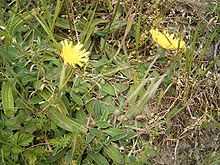Hieracium pilosella
| Hieracium pilosella | |
|---|---|
 | |
| Scientific classification | |
| Kingdom: | Plantae |
| (unranked): | Angiosperms |
| (unranked): | Eudicots |
| (unranked): | Asterids |
| Order: | Asterales |
| Family: | Asteraceae |
| Genus: | Hieracium |
| Species: | H. pilosella |
| Binomial name | |
| Hieracium pilosella L. | |
| Synonyms [1] | |
| |
Hieracium pilosella (syn. Pilosella officinarum), known as mouse-ear hawkweed, is a yellow-flowered species of Asteraceae, native to Europe and northern Asia. It produces single, citrus-coloured inflorescences. It is an allelopathic plant. Like most hawkweed species, it shows tremendous variation and is a complex of several dozens subspecies and hundreds of varieties and forms.
Common names
- Catalan: Pelosella
- Danish: Håret Høgeurt
- Czech: Jestřábník chlupáček
- French: Epervière piloselle, Piloselle, Oreille de souris, Piloselle de rat, Herbe à l'épervier, Veluette.
- German: Kleines Habichtskraut
- Spanish: Vellosilla, Pelusilla, Hierba de la Salud, Carrillejo.
- Finnish: Huopakeltano
- Hungarian: Ezüstös hölgymál
- Italian: Pilosella
- Dutch: Muizenoor
- Norwegian: Hårsveve
- Polish: Jastrzębiec kosmaczek
- Swedish: Gråfibbla
- Ukrainian: Нечуйвітер волохатенький
Description
It is a hispid (hairy) perennial plant, with a basal rosette of leaves. The whole plant, with the exception of the flower parts, is covered in glandular hairs, usually whitish, sometimes reddish on the stem. The rosette leaves are entire, acute to blunt, and range from 1–12 centimetres (0.39–4.72 in) long and 0.5–2 centimetres (0.20–0.79 in) broad. Their underside is tomentose (covered with hair). The flowering stem (scape) is generally between 5–50 centimetres (2.0–19.7 in) tall, and sprouts from the centre of the basal rosette. The flowerheads are borne singly on the scape and are a pale lemon-yellow colour, with the outermost ligules having a reddish underside. It flowers from May until August.
The plant favours dry, sunny areas. It grows well on sandy and similarly less fertile ground types. It produces stolons are which generate a new rosette at their extremity, each rosette has the possibility of developing into a new clone forming dense mats in open space. It also propagates by seeds.
Ecology
It is a known allelopathic plant, whose roots secrete several substances inhibiting root growth,[2] including its own. It can be controlled through rotation with clover and grasses where possible.[2]
Recent research claims that Hieracium pilosella exhibits an atavism by the reemergence of sexual reproduction.[3]
Similar species
Shetland Mouse Ear Hawkweed (Pilosella flagellaris subsp. bicapitata) is similar, but has two flowers per leaf stalk. Found in the Shetland Islands only, on rocky coastal grassland. It flowers from May to August..[4]
Cultivation and uses
Mouse-ear Hawkweed has become a common introduced invasive species in North America (where it is found in southern Canada and both north-east and north-west United States), and New Zealand. It is a level C noxious weed in the United States (with higher levels in the states of Washington and Oregon), and a weed in Quebec. It does not have special designations in other locations of Canada. It is known to be strongly invasive in New Zealand's tussock fields, where there are no native species of hawkweed, and biological control measures are being undertaken to control it and other hawkweed species.
Joseph Pitton de Tournefort mentions that blades covered in this plant's juices were believed to cut through stone as easily as through wood.[5]
Medicinal uses
The Mouse-ear Hawkweed contains umbelliferone, a compound similar to coumarin and a known antibiotic against brucellosis,[6] as well as a frequent active compound in sunscreen lotions. The plant is also a potent diuretic.
References
- ↑ Botanic Garden and Botanical Museum Berlin-Dahlem (June 5, 2007). "Details for: Pilosella piloselloides". The Euro+Med Plantbase. Botanic Garden and Botanical Museum Berlin-Dahlem. Retrieved 2007-12-21.
- ↑ 2.0 2.1 Carol Piening (1988-08-29). "Element Stewardship Abstract for Hieracium Pilosella". The Global Invasive Species Initiative. Archived from the original on 2006-09-18. Retrieved 2006-11-17.
- ↑ Science News, vol. 171, p. 302
- ↑ Rose, Francis (2006). The Wild Flower Key. Frederick Warne & Co. pp. 480–481. ISBN 978-0-7232-5175-0.
- ↑ Hieracium pilosella in the online Flore Laurentienne
- ↑ Bishop, G. F.; A. J. Davy (1994). "Hieracium pilosella L. (Pilosella officinarum F. Schultz & Schultz-Bip.)". Journal of Ecology 82 (1): 195–210. JSTOR 2261400.
External links
 Data related to Hieracium pilosella at Wikispecies
Data related to Hieracium pilosella at Wikispecies Media related to Hieracium pilosella at Wikimedia Commons
Media related to Hieracium pilosella at Wikimedia Commons